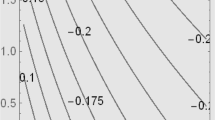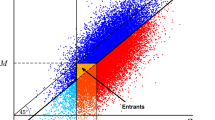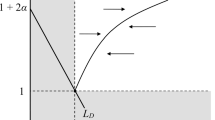Abstract
This article discusses development of optimal solutions for monopsony in the labour market for the long run (when labour and capital are both flexible). It is shown that binding minimum wages up to a certain degree pushes the monopsonists to choose a high capital intensity of production, just as high as or even higher than that chosen when there is no regulation for minimum wages. Thereby, we demonstrate the existence of re-switching effects in the tradition of Piero Sraffa. The second part of the paper recalculates and analyzes earlier results by making use of the rather general constant elasticity of substitution production function. Based on a numerical solution for optimal monopsony under different regimes (no minimum wage, minimum wages of different values, etc.), we formulate a two-period game between the government and the monopsonistic firm (‘minimum wage game’). Finally, we analyze the relationship between the elasticity of substitution on the one hand and likely levels of employment on the other hand, after introduction of minimum wages.



Similar content being viewed by others
Notes
An Internet search revealed that the article of Maurice (1974) has been cited since then only seven times (!), and adding our own makes eight.
Assuming an upward sloped labour supply function. We do not consider the case of a non-linear function.
The latter is the neo-classical wording for what Sraffa labels ‘techniques’. See Schefold (2005, p. 443).
In the relevant literature (Barr 2009), one finds the argument that a monopsonist, once confronted with minimum wages at a level of a competitive wage rate or even with higher levels, will in principle react like a competitive firm. This statement is correct, but does not alter the fact that as such, the monopsonist remains the sole demander of labour and thereby continues to be a monopsonist.
Notice that for μ → 0, the CES-function converges against Cobb-Douglas-function Y(K, L) = EL δ K 1 − δ, therefore, μ = 0 is included in the parameter space.
One may use this method of calculation for every wage function w(L) which is continuously differentiable. For reasons of simplicity, we make use of the above introduced linear wage function.
As the original pay-offs are identical for the government when establishing a minimum wage regime (3.600), one has to look for further discriminatory criteria such as expected corporate tax income or expected private investment.
References
Barr, T. (2009). Advanced intermediate microeconomics. a human centered approach. Online cf.: http://www.tavisbarr.com/index.php?page=textbook.
Barr, T., & Roy, U. (2008). The effect of labor market monopsony on economic growth. Journal of Macroeconomics, 30, 1446–1467.
Blümle, G. (1975). Theorie der Einkommensverteilung. Eine Einführung. Berlin: Springer Verlag.
Boal, W. M., & Ransom, M. R. (1997). Monopsony in the labor market. Journal of Economic Literature, 35(1), 86–112.
Cahuc, P., Laroque, G. (2009). Optimal taxation and monopsonistic labor market: Does monopsony justify the minimum wage? Cahier no. 2009–21. Ecole Polytechnique: Centre National de la Recherche Scientifique, Department d’Economie, Palaiseau Cedex.
Card, D., & Krueger, A. B. (1997). Myth and measurement: The new economics of the minimum wage. Princeton: Princeton University Press.
Manning, A. (2006). A generalized model of monopsony. The Economic Journal, 116(508), 84–100.
Maurice, S. C. (1974). Monopsony and the externally imposed minimum wage. Southern Economic Journal, 41(2), 283–287.
Metcalf, D. (2008). Why has the British national minimum wage had little or no impact on employment? British Journal of Industrial Relations, 50, 489–512.
Neumark, D., & Wascher, W. L. (2008). Minimum wages. Cambridge: MIT Press.
Schefold, B. (2005). Reswitching as a cause of instability of intertemporal equlibrium. Metroeconomica, 56(4), 438–476.
Sell, F. L., & Ruf, E. K. (2014). Wie entwickelt sich die Kapitalintensität ohne und mit Mindestlohn? Das Monopson am Arbeitsmarkt bei mehreren variablen Produktionsfaktoren. WiSt, 43(10), 543–549.
Acknowledgments
We thank Beate Sauer, Thomas Werner, Anne Oeking, Reinhard Neck, Maks Tajnikar, Petra Dosenovic Bonca and further participants of the session‚ ‘European Economics’ at the 77th International Atlantic Economic Conference held in Madrid, April 2–5, 2014 and two anonymous referees for their most valuable comments and suggestions. All remaining errors are ours.
Author information
Authors and Affiliations
Corresponding author
Rights and permissions
About this article
Cite this article
Sell, F.L., Ruf, E.K. Monopsony in the Labor Market, Minimum Wages and the Time Horizon: Some Unresolved Issues. Atl Econ J 44, 75–90 (2016). https://doi.org/10.1007/s11293-016-9484-8
Published:
Issue Date:
DOI: https://doi.org/10.1007/s11293-016-9484-8




